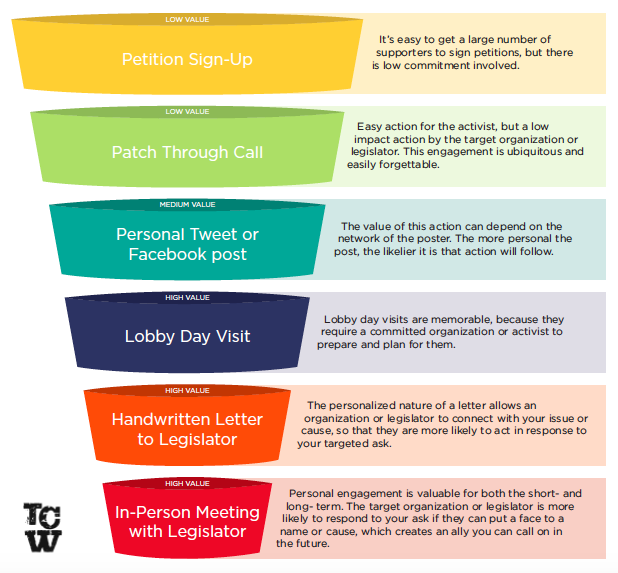
Advocacy Engagement Goes Further with A Funnel
Engaging individuals in advocacy efforts is an essential part of creating lasting change. But it can be a challenge to get people to take meaningful action, and even more challenging to keep them engaged over the long term. That's where the advocacy engagement funnel comes in.
Think of the advocacy engagement funnel to turn supporters into engaged activists. It involves defining high-value and low-value contacts and moving action-takers towards more meaningful actions. The more personal the action, the higher the value.
But what's the difference between a marketing funnel and an engagement funnel? The main difference is that a marketing funnel is used to turn leads into customers, while an engagement funnel is used to turn supporters into activists. In other words, a marketing funnel is about generating revenue, while an engagement funnel is about creating social change.
So, what do you do if someone is not engaging with your message or content? The best course of action is to delete them from your list and focus on engaging individuals who have engaged in a basic way in the past. This will save you time and resources and allow you to focus on those who are most likely to take meaningful action.
When it comes to engagement tactics, the easiest ones are petitions and patch-through calls. These methods are simple and ubiquitous, but they are also short-lived and can be forgotten quickly. The hardest engagement tactics are personal actions that require more effort and time. But these personal actions are also the most valuable in the long run, as they solidify a relationship and transform a casual action-taker into a true activist.
But where do people get stuck in the engagement funnel? The most common problem is tracking funnel steps. To avoid this issue, it's important to use a CRM or spreadsheet to track specific engagements and several at a time. This will help you keep track of where individuals are in the engagement process and allow you to move them along the funnel more effectively.
What about reconnecting with individuals who have fallen by the wayside? The key is to start with the easiest engagement tactic in the funnel and slowly build trust. This requires putting yourself in the mindset of the individual and understanding what will resonate with them. It's also important to avoid assuming that your members and activists know what to do without being told. Instead, establish a clear engagement strategy and continually engage and acquire people for the long term.
Ultimately, engaging individuals in advocacy efforts is an investment and a process that is worth the effort. By setting and tracking goals on a daily, weekly, and monthly basis, you can hold yourself accountable and increase your chances of success. Without clear goals and tracking, you are leaving engagement up to chance. But with a thoughtful and intentional approach, you can turn supporters into engaged activists and create lasting change.
Have questions about advocacy tactics and planning for public affairs campaigns? Drop us a note.